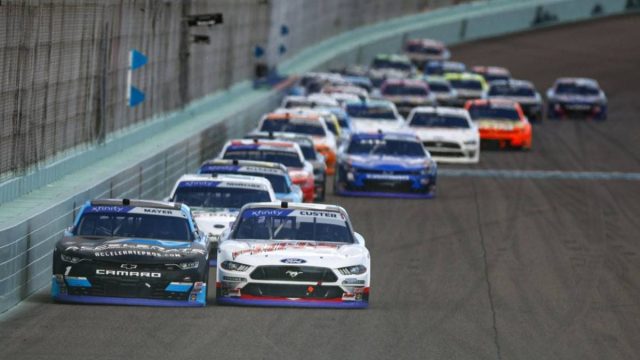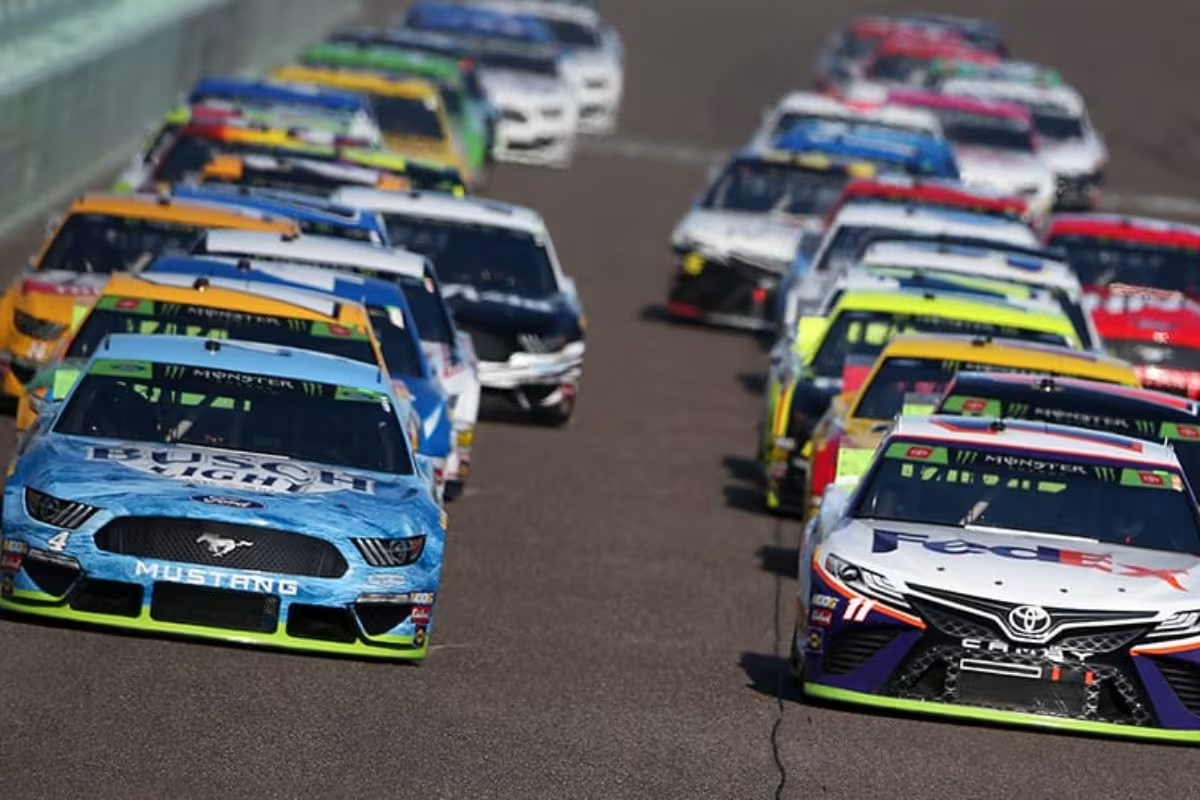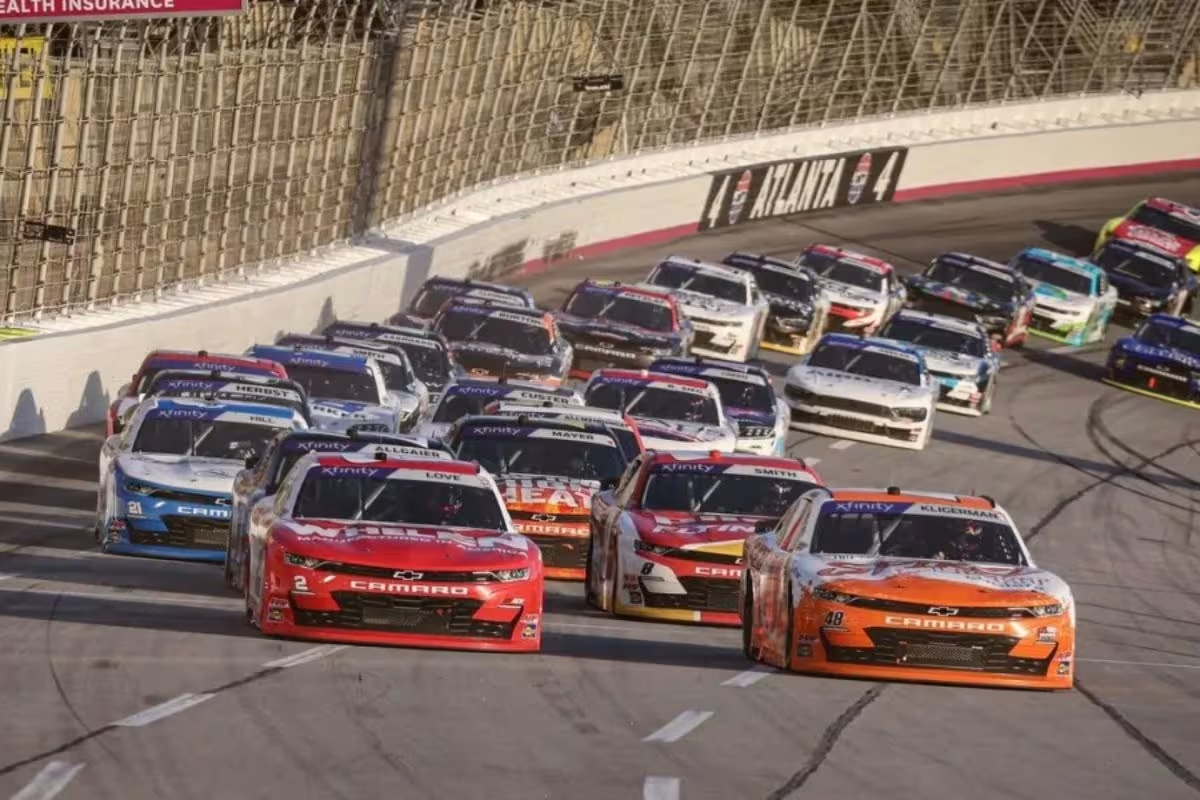Credit One NASCAR Amex Credit Card 300 Highlights: The Credit One NASCAR Amex Credit Card 300 was packed with exciting drama, starting with pre-race events that saw key drivers sidelined because of vehicle adjustments and inspections. When the race began, Chandler Smith and Cole Custer battled for the lead while dealing with noticeable tire wear challenges. During the race, important moments like Matt DiBenedetto’s exit and Riley Herbst’s crash into the wall changed team strategies. In the final laps, the intense competition between Austin Hill and Custer kept the fans on the edge of their seats.
Key Highlights
- Chandler Smith and Cole Custer battled fiercely for the lead, showcasing their competitive edge in Stage 1.
- Matt DiBenedetto’s early exit and Riley Herbst’s wall collision shifted race dynamics and heightened tensions in Stage 2.
- Austin Hill’s efficient pit stops and subsequent lead demonstrated the importance of crew performance in Stage 3.
- Strategic positioning and tire management became critical as green flag pit stops began in Stage 4, influencing race outcomes.
- Intense competition peaked as drivers sought to capitalize on strategic advantages and track position throughout the race.
Pre-Race Developments
In the lead-up to the Credit One NASCAR Amex Credit Card 300, several notable developments emerged, setting the stage for an unpredictable race. Particularly, Anthony Alfredo, Jeremy Clements, and Shane Van Gisbergen found themselves relegated to the rear of the starting grid due to unapproved adjustments to their vehicles. This situation not only complicates their racing strategies but also poses a challenge in maneuvering through the field, especially considering the competitive nature of the pack at the outset.
Complementing the drama, Matt DiBenedetto‘s failure to pass inspection deprived him of an opportunity to qualify. This incident emphasizes the critical importance of compliance with NASCAR regulations, as even minor discrepancies can lead to substantial repercussions. DiBenedetto’s absence from the front of the field may influence the dynamics of the race, as teams will be acutely aware of the potential impact of his performance if he were to make a late surge from the back.
Furthermore, Thomas Annunziata’s spin during practice raises further concerns about car handling and driver confidence. Such incidents can serve as a precursor to potential issues during the race, particularly regarding tire wear and vehicle stability.
As teams analyze performance data, they must consider how these pre-race developments will affect their strategies moving forward. These factors contribute to an atmosphere rich with uncertainty, making the Credit One NASCAR Amex Credit Card 300 a race that could shift dramatically as the laps unfold and strategies are tested under the strain of competition.
Stage 1 Highlights
Kicking off the Credit One NASCAR Amex Credit Card 300, Stage 1 unfolded with intense competition and tactical maneuvers that set the tone for the race ahead.
The early laps saw Chandler Smith seize the lead from the outside, with Sheldon Creed closely trailing. However, by lap four, Aric Almirola executed a daring three-wide maneuver, propelling himself to third place and showcasing the aggressive nature of the drivers.
As the stage progressed, the intensity of competition heightened. Notable events included:
- Cole Custer and Chandler Smith’s fierce battle for the lead, culminating in Custer’s eventual takeover on lap 28.
- A noteworthy two-second falloff in lap times by lap ten, indicating tire wear and necessitating tactical adjustments from the teams.
- The effective navigation of lap traffic by the top three drivers—Custer, AJ Allmendinger, and Almirola—demonstrating their adeptness in challenging conditions.
Stage 2 Highlights
Following the competitive energy established in Stage 1, Stage 2 of the Credit One NASCAR Amex Credit Card 300 continued to highlight the drivers’ skills and tactical decision-making under strain.
The stage unfolded with notable pit strategies, as Matt DiBenedetto‘s early exit from the race on lap 48 not only impacted the 19th position but also signaled a shift in the dynamic of the event. Lead lap cars utilized this opportunity to pit for four tires, with Austin Hill emerging as the leader off pit road, exhibiting his team’s superior strategy.
As the race resumed on lap 53, Hill maintained his lead against Aric Almirola, demonstrating his ability to fend off challenges. However, the stage was punctuated by incidents that tested the drivers’ resolve.
Riley Herbst’s collision with the wall on lap 66, followed by Justin Allgaier’s scraping of the wall from 8th position, showcased the intense stakes and the thin margins for error.
The caution on lap 87, triggered by Nick Leitz’s spin, further compounded the tension, allowing Riley Herbst to capitalize on the free pass and regain competitive ground. Meanwhile, Sammy Smith’s pit stop on a closed pit road emphasized the demands of tactical adjustments mid-race.
As Stage 2 concluded, the drivers not only demonstrated their racing skill but also highlighted the critical role of strategy, resilience, and adaptability in the face of evolving race conditions.
Stage 3 Highlights
Stage 3 of the Credit One NASCAR Amex Credit Card 300 unfolded with heightened intensity, demonstrating the drivers’ relentless pursuit of victory amid tactical pit actions and fierce on-track battles.
As the stage progressed, crucial moments emerged that not only affected the leaderboard but also depicted the tactical complexities inherent in NASCAR racing. The action commenced on lap 91 when lead lap cars dove into the pits, with Austin Hill emerging victorious from the pit road, a proof of his crew’s efficiency.
However, not all teams fared well; Jeb Burton struggled with his pit entry, while Kyle Weatherman and Dylan Lupton encountered their own mishaps, highlighting the intense stakes of pit stops.
By lap 96, Hill, now leading the field, faced off against Cole Custer in a compelling duel that exhibited their respective skills.
Key highlights from this stage include:
- Austin Hill’s impressive overtaking of Aric Almirola, securing third place, demonstrating his growing momentum.
- A dramatic battle for the lead between Hill and Custer, reflecting the finely balanced competition.
- A caution on lap 122 due to Josh Williams’ tire failure, which altered the strategies of multiple teams, particularly benefiting Jesse Love, who gained three positions during the subsequent pit stop.
As the stage concluded, Hill’s dominance was evident, but the unpredictability of NASCAR guaranteed that the next challenges loomed on the horizon.
Stage 4 Highlights
As the race progressed into Stage 4, the atmosphere intensified, with drivers keen to capitalize on their strategies and positioning. Austin Hill, starting from the pole, initially led the pack but quickly faced fierce competition from Cole Custer, who executed a masterful restart from third position to seize the lead by lap 128. This crucial moment highlighted the significance of track position and timing in race strategy.
As the race unfolded, numerous incidents shaped the dynamics on the track. Significantly, William Sawalich’s misstep on lap 146 saw him hitting the wall while battling Brandon Jones, forcing an unscheduled pit stop that would hinder his progress.
Meanwhile, the pit strategy began to take center stage with green flag stops initiated by top contenders like Aric Almirola and Cole Custer, emphasizing the critical nature of tire management and fuel conservation.
News in Brief: Credit One NASCAR Amex Credit Card 300 Highlights
The Credit One NASCAR Amex credit card 300 exhibited a series of intense developments throughout the race stages. Each segment offered unique highlights, from tactical movements to unexpected incidents that tested driver skill and teamwork.
The climax of these factors not only influenced the final standings but also provided valuable insights into race dynamics and driver performance. Altogether, the event emphasized the intricate relationship between strategy and execution in the competitive domain of NASCAR racing.
ALSO READ: Credit One NASCAR Amex Credit Card 300 Predictions: Who Will Dominate Homestead’s Round of 8?



